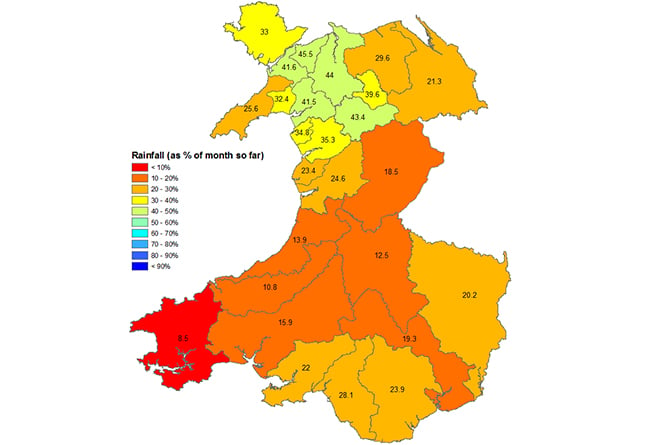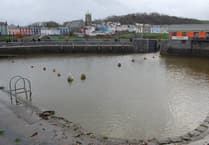FOLLOWING the extended period of dry weather, Natural Resources Wales confirmed that the trigger thresholds have been met to move south-west Wales into drought status on Friday, 19 August.
NRW’s decision to move from prolonged dry weather status to drought for the area was agreed and shared with a meeting of the Welsh Government’s Drought Liaison Group and after consideration of the exacerbated pressures the high temperatures and lack of significant rainfall have had on the environment in this area.
The rest of Wales remains in prolonged dry weather status but concerns still remain. While essential supplies of water remain safe, the public and businesses in drought affected areas should be very mindful of the pressures on water resources and should use water wisely. NRW continues to closely monitor the situation across Wales, working with partners and will take action as required.
Natalie Hall, sustainable water manager for NRW, said: “Prolonged dry weather can lead to drought when rainfall remains low. This can impact some of our most precious habitats and species as well as systems we often take for granted, such as our water supplies.
“We have decided to declare a state of drought in south-west Wales after it was clear the lack of rain and recent heat have put a huge strain on our rivers, reservoirs and groundwater levels.“
The areas affected are: north Ceredigion (Rheidol, Aeron, Ystwyth), Teifi, Pembrokeshire (Eastern and Western Cleddau) Carmarthen (Tywi and Taf), Swansea and Llanelli (Tawe and Loughor), Neath Port Talbot and Bridgend (Neath, Afan, Ogmore).
What the shortage of water means
Less grass for livestock
The NFU is reporting reduced rates of grass growth needed for grazing livestock and also second and third crop silage, impacting stocks of fodder for the forthcoming winter.
South-west Wales received just 65.5 per cent of its average rainfall in July and all river levels in the area are lower than expected for this time of the year, with the Ewenny, Teifi and Taf exceptionally low.
Low groundwater levels coupled with record high temperatures, have also put a strain on the region’s ecosystems as well as public water supplies in Pembrokeshire and parts of Carmarthenshire.
The rest of the country continues to experience a period of prolonged dry weather, despite there being some recent rainfall.
Across the rest of Wales, the majority of rivers across Wales are lower than expected for the time of year, with many exceptionally low including the Alyn, Conwy, Clwyd, Taf, Teifi, Ewenny, Wye, Usk and Ebbw.
Between March and July Wales received just 61 per cent of its expected rainfall resulting in the driest five-month period in 40 years
What the shortage of water means
Unreliable water supplies
Farmers are reporting that spring-fed water supplies, streams and boreholes are becoming unreliable, as well as lower pressure from mains supply in certain areas, particularly where farms are adjacent to other users such as caravan parks.
NRW is advising the residents of Pembrokeshire to follow water conservation advice given by Dŵr Cymru/Welsh Water, who have introduced a temporary use ban, more commonly known as a hosepipe ban, which also came into effect last Friday.
“While certain parts of Wales may be experiencing rain, it can still take a long time to recover from drought, making water a precious resource,” Ms Hall said.
“We’re urging the public to save water where possible; you can find the latest ad advice on water by visiting your water company’s website or Waterwise (www.waterwise.org.uk).”
The water shortage comes as Wales endures its driest year since 1976, with record temperatures and record levels of demand for water.
What the shortage of water means
Buying in dearer feeds
The lack of grass means that some farmers are having to buy in supplementary feed to, for example, creep feed lambs for finishing which is adding costs. Farmers are also making the decision to reduce stocking levels.
A 2020 Drought Plan undertaken by Welsh Water said that in north Ceredigion “even under more severe drought events, reservoir levels would not fall below into the Emergency Storage action zone”.
“So there no real risk of us needing to implement extreme supply side measures,” a report on the plan said.
“The testing has however shown that reservoir levels could fall into the Severe Drought Action Zone and so we still need ensure that during a drought, we carefully manage our water resources.
“To provide an additional level of drought resilience, we have retained one environmental supply side option to provide extra water resource, in the event that this is required.”
For mid and south Ceredigion, Welsh Water admitted in the report that “the performance of our reservoirs during the summer of 2018 gave us some concerns that there may be a higher drought risk than initially identified.”
“Overall, our scenario testing and Extreme Value Analysis tell us that the risk of needing to implement extreme supply side measures (i.e. widespread pressure management or water rationing) is negligible but that during these severe drought events, we need to ensure careful management of our water resources as reservoir storages will fall to levels we have not experienced before.”
Welsh Water imposed the hosepipe for customers in Pembrokeshire and a small adjoining part of Carmarthenshire. Customers in the affected area have already been sent letters to advise them that they will not be able to use a hosepipe to carry out activities in and around their properties such as watering plants or filling paddling pools or hot tubs.
What the shortage of water means
Lower yields on crops
The NFU reports that growers are unable to irrigate their crops with the result that some crops are dying off early. Lower than average yields could be expected for some crops as a result.
Pembrokeshire has only seen just over 60 per cent of the expected rainfall between March and July and since becoming aware of the lower than normal rainfall, the company has undertaken a number of activities to help conserve water in the area. This has included increased detection and repair of leaks, plus the use of water tankers to respond to peak periods of demand in some parts of the county to help maintain supplies.
For Welsh Water, the ban applies to only four per cent of its customers and all customers in the affected area have been written to.
If anyone wants to check if they are in the affected area they can use a handy postcode checker that Welsh Water has available on its website – dwrcymru.com/drought

Ian Christie, Welsh Water’s managing director of water services said: “As a responsible company, we have detailed plans in place to ensure we continue to supply customers especially when an area falls into drought which includes introducing temporary use bans.
“It is not a decision we take lightly because we know the inconvenience it can cause, but if we don’t take action now then there would be a real risk of further restrictions later which is something we really want to avoid for our customers. With no significant rain in the forecast it is important that we all work together to make sure the water continues to flow.
“We are also doing our bit as well and have increased the number of people in the area we have finding and fixing leaks. This has seen us increase manpower in the area by 70 per cent which in turn means we are now detecting and fixing 40 per cent more leaks compared to 2021. We do however appreciate that customers can get frustrated if a leak isn’t fixed as soon as they report it to us.
“While the majority of leaks are fixed immediately, there are some which can prove to be more complex and requires traffic management so the work can be done safely. These then can take longer however we can assure our customers that we are doing everything we can to fix each one as quickly as we can.”
Mr Christie added: “We really do appreciate the steps people have already taken to limit the amount of water they use but we would urge everyone now in the affected area to respect the ban and not use a hosepipe. There are exceptions, particularly for those holding a Blue Badge or on our Priority Service Register. A full list of what people aren’t allowed to do under the ban and the exceptions can be found on our website.”

.png?width=209&height=140&crop=209:145,smart&quality=75)
.png?width=209&height=140&crop=209:145,smart&quality=75)


Comments
This article has no comments yet. Be the first to leave a comment.